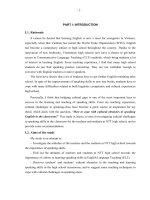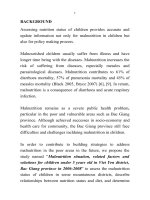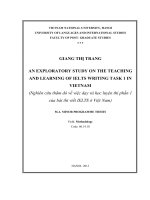A study on cultural obstacles to the teaching and learning of speaking skills in the classroom of grade 10 at nguyen tat thanh high school
Bạn đang xem bản rút gọn của tài liệu. Xem và tải ngay bản đầy đủ của tài liệu tại đây (277.5 KB, 38 trang )
-1-
PART I: INTRODUCTION
I.1. Rationale
It cannot be denied that learning English is now a must for youngsters in Vietnam,
especially when that Vietnam has joined the World Trade Organization (WTO). English has
become a compulsory subject at high school throughout the country. Thanks to the
innovation of new textbooks, Vietnamese high schools now have a chance to get better
access to Communicative Language Teaching (CLT) methods, which bring students a lot of
interest in learning English. From teaching experience, I find that many high school students
do not find speaking practice interesting. They are not confident enough to converse with
English teachers or native speakers.
The facts have shown that a lot of students have to get further English retraining after
school. In spite of the improvements of speaking skills in new text books, students have to
cope with many difficulties related to both linguistic competence and cultural experiences
high school.
Personally, I think that bridging cultural gaps is one of the most important keys to
success in the learning and teaching of speaking skills. From my teaching experience,
cultural challenges in speaking-class have become a great source of inspiration for my thesis
which deals with the question, “How to cope with cultural obstacles to speaking English
in the classroom?” This study is, hence, to aim at investigating cultural challenges to
speaking skills in the classroom for the teachers and students at NTT high school, and to
provide some recommendations.
I.2. Aims of the study
My study is an attempt to:
- Investigate the attitudes of the teachers and the students at NTT high school towards
the importance of speaking skills,
- Find out the attitudes of teachers and students at NTT high school towards the
importance of culture in learning speaking skills in English Language Teaching (ELT),
- Discover teachers’ and students’ cultural obstacles to the teaching and learning
speaking skills in the high school classrooms, and to suggest some teaching techniques to
cope with cultural challenges in speaking-class.
-2-
I.3. Scope of the study
To develop speaking skills in the classrooms at NTT high school, the teachers have
made a lot of effort to motivate the students to participate in speaking-class effectively.
However, in the thesis, the researcher wants to find out the attitudes, as well as the cultural
awareness in teaching and learning spoken English of the teachers and the students of 10 th
grade at NTT school; the cultural obstacles such as different ways of thinking, lack of
cultural background knowledge and the learning attitudes, and then to give some
recommendations for improvement.
I.4.The research questions
My study aims at answering the following research questions:
- Do teachers and students at NTT high school really focus attention to speaking skills?
- How do teachers and students at NTT high school appreciate the role of culture in
mastering speaking skills?
- What typical cultural obstacles should be overcome in the teaching and learning of
speaking skills?
I.5. Methods of the study
To realize the aims of the study, both qualitative and quantitative methods will be used.
The data collected for the study will mainly from two sources: 100 students of 10th grade and
10 teachers of English at NTT high school. Survey questionnaires are used to collect
information and evidence for the study.
All comments, remarks, recommendations, and conclusions provided in the study will
be based on the data analysis.
I.6. Design of the study
This study is going to be divided into five parts, as follows:
Part I, Introduction, deals with the reason for the research and the aims, scope and
methodology of the study. The research questions are also raised in this part.
Part II, Development, consists of the three following chapters:
* Chapter 1 is intended to give some theoretical background related to culture,
language and speaking skills.
* Chapter 2 provides an analysis on the attitudes of the teachers and students at
-3-
NTT towards the position of culture and speaking skills in ELT and towards
cultural factors in developing speaking skills. Also, the current teaching and
learning of speaking skills accompanied by cultural challenges in the classroom at
NTT will be discussed. Information about teachers, current teaching methods,
materials and problems, is mentioned.
* Chapter 3 focuses on recommendations about using some activities to get
over cultural difficulties and improving speaking skills in the classroom.
Part III, Conclusion, addresses the key issues in the study, summarizing some
shortcomings revealed during the process of completing this research paper.
-4-
PART II: DEVELOPMENT
CHAPTER 1: LITERATURE REVIEW
1.1. Culture and its role in language teaching
1.1.1. Definitions of culture:
The term culture has been defined in various ways, which brings different views on
cultural aspects. It is true to say that the number of definitions of culture is the same as the
“fields of inquiry into human societies, groups, systems, behaviors and activities.” (Eli
Hinkel, 1999).
According to Oxford Advanced Learner’s dictionary (1995: 285), culture is “art,
literature, music and other intellectual expressions of a particular society or time”. This
concept mentions general culture relating to the exposed parts of culture, which are easily
recognized such as language, food, clothes, etc. Besides, culture is considered an “iceberg”
which consists of not only visible but also hidden parts. The hidden parts of culture such as
socio-culture beliefs, communication styles, and attitudes, which cause cross-cultural
difficulties, have significant influence on the way human behave and interact with each other.
According to Ruth Benedict, cited in Brown “Culture is what binds (people) together.”
Culture is all the accepted ways of behavior of a given people belonging to some particular
group; it is that part of learned behavior shared with others. The concept include a group’s
way of thinking, feeling, and acting, and fixed patterns for doing certain things.
According to Thompson (1990:132), “the pattern meaning embodied in symbolic forms,
including actions, utterance and meaningful objects of various kinds, by virtue of which
individuals communicate with one another and share their experiences, conceptions and
beliefs”.
Culture is a shared, learned, symbolic system of values, beliefs and attitudes that shapes
and influences perception and behavior - an abstract "mental blueprint" or "mental code"
Culture must be studied "indirectly" by studying behavior, customs, material culture
(artifacts, tools, and technology), language, etc.
The above definitions seem to mention specific behaviors and beliefs of a general
society, which are passed from generation to generation. The various definitions of culture
-5-
provide culture with different values. In this paper the author would like to emphasize the
influence of cultural factors on the teaching and learning of speaking skills in classrooms, so
the definition below should be taken to give the foundation for this thesis.
“Culture in language learning is not an expendable fifth skill, tacked on, so to speak, to
the teaching of speaking, listening, reading and writing. It is always in the background, right
from day one, ready to unsettle the good language learners when they expect it least, making
evident the limitations of their hard-won communicative competence, challenging their
ability to make sense of the world around them.” (Kramsch, 1993:1)
1.1.2. The role of culture in language teaching
To emphasize the importance of culture in learning and teaching foreign languages Eli
Hinkel (1999) has said,” Applied linguists and language teachers have become increasingly
aware that the second or foreign language can rarely be learnt, or taught, without
addressing the culture of the community in which it is used .This can be with the idea that
culture plays an important role in teaching and learning language.” (Eli Hinkel, 1999)
In fact, language is part of a culture; language is deeply embedded in a culture; language
and culture cannot be separated, and we cannot teach a language without teaching a culture. It
means that teaching language is teaching culture. Therefore, teaching culture has been
integrated into language teaching programs and teaching materials in one way or another.
Many educators have applied these programs into real classroom activities and teaching
materials. This has been done, also, with the aim of bringing the most effective ways to teach
foreign languages.
Brooks stated that, “As language teachers we must be interested in the study of culture
“the social scientists’ sense of the word not because we necessarily want to teach the culture
of the other country but because we have to teach it. If we teach language without teaching
at the same time the culture in which it operates, we are teaching meaningless symbols, or
symbols to which the student attaches the wrong meanings. Unless he is warned or he
received cultural instruction, the student will associate American concepts or objects with
the foreign symbols.” (Cited in Nguyen Van Do: 2007)
According to Kramsch, language plays a crucial role not only in the construction of
culture, but in the emergence of cultural change. Culture shapes our view of the world. And
language is the most representative element of any culture. It is true to say that “to know
-6-
another’s language and not his culture is a very good way to make a fluent fool of one’s
self.”(Winston Brembeck cited in Nguyen Quang (1983). Without the study of culture,
foreign language instruction is inaccurate and incomplete. For foreign language students,
language study seems senseless if they know nothing about the people who speak it or the
country in which it is spoken.
From these ideas of culture, it is actually hard for language learners to communicate well
without knowledge of culture such as codes of behaviors, and different beliefs, etc. The facts
have shown that some breakdowns in communication between inter-collators have been
caused just by cultural misunderstandings. For example, when an Asian communicates with
an American or Westerner, they take no care of eye contact unless they know direct eye
contact is considered as conveying honesty in English cultures. What would happen if
someone knew the expressions of greetings very well but, with an inadequate knowledge of
culture, he didn’t know how to response “how are you?” , or even how to shake hands in
business? It is easy to fail in learning English if learners are not provided with cultural
values.
According to Barry Tomalin &
Susan Stempleski,(1993) one of the seven goals of
teaching culture in language teaching is to create and encourage learners’ curiosity about the
target culture, which is considered one of the motivations for language learners. The more
they know the target culture, the more they want to explore it and their own culture as well,
which helps them find differences and similarities among cultures. With an adequacy of
cultural knowledge, learners can have deep understanding of the diversity of cultures and
adjust themselves to real situations. The comparisons among cultures help them not only to
have a wider view of culture but also avoid taboos or stereotypes.
Students can distinguish the differences of, for example, what is “appropriate” in their
own culture but may be “inappropriate” in another. They pay more respect to the target
culture instead of devaluing it because there is no culture considered superior or inferior.
Culture denotes a body of shared knowledge, that is, what people must do and follow to
make it easier to interpret or make sense of another’s utterance or actions. “This is true also
of the change that we might want to bring about by teaching people how to use somebody
else's linguistic code in somebody else's cultural context. Teaching members of one
community how to talk and how to behave in the context of another discourse community
potentially changes the social and cultural equation of both communities, by subtly
-7-
diversifying mainstream cultures” (Kramsch, 1993:4)
Another thing which should be mentioned here is that the aim of English learning is to be
able to communicate in the language and use the language properly. The capacity of making
oneself understandable is thus taken into consideration. Cultural knowledge offers a range of
distinct options and patterns related to different areas of everyday life. So students not only
get information about cultures, but also practical use in appropriate situations. When students
get deep understanding of both English cultures and their own, they are better ready to speak
English or encounter real situations.
Facts have shown that culture and language are two sides of a piece of paper. Language
expresses, embodies, and symbolizes cultural reality and in return cultural knowledge makes
language alive. Therefore, they co-exist and support each other. The idea of the world is
captured by culture. And language is the most typical component reflecting culture.
Therefore, teaching and learning language, separated from knowing culture, can not be done
properly. “It is necessary for foreign students to have knowledge of the culture of native
speakers”. (Debora Beck). As a result, this is the reason why we can come to the conclusion
that teaching language is more than teaching a system of syntax and lexicon.
Culture is not static. It is constantly changing because it depends on many social factors.
For example, during American meals parents often reminded children of some starving poor
country, like China, when children left a lot of food after they finished eating, but now they
mention the Third World instead. As Eli Hinkel wrote, “culture denotes a body of shared
knowledge, that is, what people “must know in order to act as they do, make the things they
make, and interpret their experience in the distinctive way they do” (Quinn & Holland, 1987:
4). Everyone should easily realize that successful communication is determined not only by
shared language but also by socio-cultural factors.
In conclusion, language teaching requires much more than words and grammatical
structures. It goes without saying that culture is regarded “as mere information conveyed by
the language, not as a feature of language itself, culture awareness becomes an educational
objective in social practice, and culture becomes the very core of language teaching.”
(Kramsch, 1993:8)
1.2. Speaking skills and their position in English language teaching (ELT)
1.2.1. Definition of speaking skills
-8-
1.2.1.1. What are skills?
In the past, a skill has been likened to a job, “A skill is the learned capacity or talent to
carry out pre-determined results often with the minimum outlay of time, energy, or both.”
Skills can be classified in two main types: domain-general and domain-specific. For
example, in the domain of studying, some general skills would include teamwork, individual
work, self-motivation, and others, whereas domain-specific skills would be useful only for a
certain subject.
Skills in language often depend on numerous variables. “Skill is different from
knowledge provided. A fundamental difference is that while both can be understood and
memorized, only a skill can be imitated and practiced” (Martin Bygate,1987:4). For
example, when we think about how to use language, we often spend much time using
sentences that is we practice, and not much time on knowledge. Therefore, it is a waste to
study a language without practice, and teachers try to encourage students to take advantage
of time in classrooms to speak English to one another. It is undeniable that knowledge of the
language is not enough for language learners, we need skills. We first obverse, practice, and
then gradually gain the skills to succeed. The more we practice the more successful we are.
1.2.1.2. What are speaking skills?
Speaking is the productive skill in the oral mode. It, like the other skills, is more
complicated than it seems at first and involves more than just pronouncing words.
The definition of speaking has been expanded by Brown with some trends, such as
communication activities, with various settings one- to-many, small group, one-to-one and
mass-media, using communication for the specific purposes of informing, persuading and
solving problems and basic competencies or everyday life. So speaking skills, or oral
communication, is considered an “interactive process in which an individual alternately
takes the roles of speaker and listener, and which includes both verbal and nonverbal
components.” (Rubin & Donald L: 1985 cited in Mead & Nancy. A)
Speaking is not spoken writing. It is different from other skills in the teaching and
learning of language. For example, it needs limited time in response and it is not easy to
correct when an utterance is made. The speakers must be responsible for their utterances in a
limited time and make sense with what they are saying.
Speaking skills, together with writing, are a production skill. It is different from others
-9-
in its time pressure, which “allow limited time for deciding what to say, deciding how to say
it. Saying it and checking that the main intentions are being realized” (Martin Bygate, 1987)
and then adjust their speech based on reaction from listeners. “The words are being spoken
as they are being decided and as they are being understood”.
Moreover, once spoken, the words are gone. So when speaking, speakers need to preorganize the message in an effective way. For example, sentences should be not as complex
as they might be in writing .We often “make syntactic mistakes because we lose place in the
grammar of our utterances. Mistakes are also made in both the message and the wording.”
(Martin Bygate, 1987:13)
According to Martin Bygate (1987), speakers keep a different position from other
activities. In speaking they need imagination and patience. Speakers are quickly made aware
of how and where the communication is headed and adapt what they are saying directed by
their listeners’ reaction. So during speaking, speakers are responsible for making themselves
understandable to listeners through selected and adapted messages based on listeners’
understanding feedback. This means that speakers use devices in order to facilitate
production.
1.2.2. The position of speaking skills in ELT
It seems clear that speaking is the key component to ELT. Teachers and students are
aware of the role of speaking in ELT. In fact, different skills have certain roles in ELT, but
the utmost aim of ELT learners is to use spoken language to communicate with others.
First, speaking is to enable learners to communicate in the target language. As we can
see, communication is a basic demand for everyone, so if we want to communicate we
should learn how to speak. For the increasing demands for joining in a lot of fields in life,
not only domestically but also overseas, learners need to be able to communicate well as
they ask for information to serve their different purposes.
Second, as we have seen, one of the objectives in teaching language is to prepare
learners to be able to use the language. They must be aware that speech maintains a higher
position than other skills. Martin Bygate (1987) says that speaking “is a medium through
which much language is learnt, and which for many is particularly conductive for learning”.
This means that there is a lot of emphasis put on the importance of speaking skills. It is only
when speaking skills are mastered that other skills like listening, writing, and reading can be
- 10 -
effectively achieved.
In sum, speaking skills, which play a vital part in the teaching and learning of English,
require the efforts of both the teachers and the students to gain a mastery of it. Martin Bygate
(1987) proved that speaking not only requires linguistic but also socio-cultural competence,
which asks speakers to understand the what, when, why, and in which way to speak. In order
for a learner to speak English fluently, apart from a limited amount of grammar and
vocabulary, teachers must be aware of the contribution of other factors involved in speaking.
1.3. Cultural factors in the teaching and learning of speaking skills in
classrooms
1.3.1. What cultural factors influence on the teaching and the learning of speaking
skills in classrooms?
Culture and language exist in the same relationship as that in which, within language,
meaning and expression develop together. Today educators have become aware of the
importance of cultural factors in the teaching of speaking skills and, too , aware of the great
influence of inferences between two cultures- target and learner’s cultures- on these teaching
and learning skills.
This is seen, firstly, in the methodology applied in classrooms and the beliefs by
teachers in their instruction of foreign languages. They often teach what they believe. Even
though teachers base what they teach on textbooks of the State syllabus, Vietnamese culture
affects the reality of teaching speaking English in the classroom. Students often consider
teachers information providers or knowledge givers, and they pay a lot of respect to teachers
by keeping silent and asking no questions in the classroom. Students, as well as society as a
whole keep the belief that teaching is the noblest profession, and teachers, therefore, need to
be highly respected.
Students really lock into the classroom structure and the things teachers say, which is
absolutely right in their minds. As a result, this leads to silence, even during speaking
lessons. Teachers’ talk is occupied more than that of the learners’. This teacher-centered
methodology has long been used at high school in Vietnam.
Secondly, culture affects the educational system of Vietnam. Students at high school are
not totally aware of the role of English in an open door and market economy. They learn and
expect to pass the exam at the end of each term with the belief that they will be able to be
- 11 -
retrained at college afterwards.
Moreover, in Vietnam, students are affected by Confucianism, which respects
collectivism more than individualism, in contrast to Western countries. These countries
highly appreciate personal independence, and fierce competition; that is, individualism. This
may be one of the major problems for learners during speaking activities in classrooms,
especially in group work. They prefer to listen to the ideas of others rather than express their
own opinions.
Another cultural aspect is that of the students’ attitude towards learning. “Learners’
attitudes have an impact on the level of L2 proficiency achieved by individual learners”.
(Rod Ellis, 1994:198). In a Vietnamese classroom, the classmates need to live in harmony,
like a union, so discussions using argument seems to be impolite. During discussion they
present analysis and criticism which they feel can cause a distance between them. When one
is brave enough to say something, the whole class takes note, and he or she will become the
main focus. The rest of the class will consider him exceptional. In this vein, the expression
“silence is gold" becomes another major cultural barrier to the improvement of spoken
English. For this culture based reason, discussions, debates, group activities, and productive
interactions between students and teachers are difficult to be fully utilized.
But in fact, with an active speaking class, new ideas and many improper utterances can
be made. Rod Ellis (1994:200) also states that positive attitudes towards the L2, its speakers,
and its culture can be expected to enhance learning and negative attitudes to impede learning.
In order to sharpen communicative skills, students should aggressively participate in
class and group activities but the belief that losing face is a shame affects student
participation during speaking activities in class. Learners would rather be considered passive
ones than lose face in front of the class. This is the reason why some keep silent in class even
when they know the answer. Or why, they never raise ideas in discussion. They are afraid of
making mistakes. This is quite different from English cultures, in which students tend to
learn from mistakes.
Above all, what is blocking communication development here are differences in cultures
- cultural beliefs about what matters in life and how people should behave. In Vietnam,
skillful self-expression, critical thinking, and the ability to engage in discussion and
argument, which individualistic societies uphold, are not always good behavioral norms they
- 12 -
have grown up with. In their view, a quiet student learns more and is more respectful than
one who speaks up, and takes time away from the teacher’s lesson.
Speaking ability becomes perfected through an endless trial and error process. Even
though teachers encourage students not to be afraid of making mistakes while speaking
English, Vietnamese students hesitate to express their opinions freely because they are
concerned about how others will see them and they have been brought up in the collectivistic
cultural mode.
It is known that different countries have different ways of speaking because of both the
use of linguistic codes and the ways they use the codes. However, sometimes there is a thin
line between them or between different “grammars” and different “ethnographic of
speaking” (Hymes: 1962). Different codes in cultures cause learners trouble, or
misunderstanding, when speaking.
Moreover, the lack of target culture may cause negative cultural transfer when learners
are producing and interpreting the target languages because they will transfer from their own
language. Students may use Vietnamese codes to speak and sometimes they translate on a
word-by-words basis. They apply the way they think in their mother tongue to form speech
in English and pay no attention to the meaning beyond the words. The dialogue followed can
be seen as an example; a Vietnamese would apply this approach to the situation of an
employee asking for leave by beating around the bush instead of getting directly to the main
point. As seen here:
Boss:
“My boss, the weather is getting horrible, isn’t it?”
Employee:
“The old often get sick due to this kind of weather.”
“My Mum has been sick now.”
“May I have some days off to see her in the hospital?”
1.3.2. What aspects of culture should be taught in the foreign language classroom?
Language teachers must have a certain awareness of the foreign culture and its effect on
the language being taught. They need to understand that language can’t be translated wordfor-word. Words carry different meanings in different situations and contexts. In addition to
- 13 -
that, the intonation and pitch of an utterance may also convey different meanings. We also
need to obtain nonverbal language, like gestures, which play an important role in
communication and imply different meanings in different languages. Another education
factor is that different ways of addressing people need to be taught because of their
differences.
Additionally, all cultures have taboo topics. Learners need to be aware of what should or
should not, be said in different situations. This is an important part of knowing a language. It
is also understood that grammatical components in language are used to indicate different
physical parts of the world.
When considering language learning, it would follow that the learning of both languages
would have the cultural goals, and that students would be learning these aspects of culture in
a comparative process.
There are two main components of culture in the language classroom. "One component
is the anthropological or sociological culture: the attitudes, custom, and daily activities of a
people, their ways of thinking, their values, their frames of reference. Since language is a
direct manifestation of this phase of culture, a society cannot be totally understood or
appreciated without knowledge of its language. The other component of culture is the
history of civilization. Traditionally representing the “culture” element in foreign language
teaching, it includes geography, history, and achievements in the sciences, the social
sciences, and the arts. This second component forms the framework for the first: it
represents the heritage of a people and as such must be appreciated by the students who
wish to understand a new target culture" (Valette, R.M.1986: 179). It is seen that language
and culture are inseparable.
Growth; refinement; fine arts; patterns of living; and, a total way of life are five
meanings of culture identified by Nelson Brooks. Patterns of living are when and what they
eat; how they make a living; the attitudes they express towards friends and members of their
families; and which expressions they use to show approval or disapproval. In this sense,
culture is a body of ready-made solutions to the problems encountered by the group.
If we provide our students only with a list of facts of history or geography and a list of
lexical items, we have endowed them with an intimate view of what life is really like in the
target culture. Students need to feel positive about what they are doing and what they are
studying. Even weak students take pride in their notebooks when they’ve worked hard to
- 14 -
make them presentable. Recent studies demonstrate that if students have positive attitudes,
they will do well. Foreign language teachers should aim at developing high interest in ELT
studies through cultural awareness.
In conclusion, the teaching of culture should become an integral part of foreign
language instruction. It should exist during the whole process of teaching and learning
speaking skills at different level of students’ language proficiency.
- 15 -
CHAPTER 2: THE STUDY
2.1. Design and methodology
2.1.1 Subjects of the study
The subject of the study consists of 100 students of 10th grade and 10 teachers who are
responsible for teaching English 10 at NTT high school.
The teachers are young aged from 25 to 33. Most of them have at least 5 years of
teaching experience. Two out of ten teachers are male. Not all of them graduated from
Foreign Languages College - Vietnam National University, Hanoi. Two of them have been
to English - speaking countries. Every year all of the teachers have chances to meet and work
with native teachers from Australia, America, and England..., in NTT high school for a short
time. The teachers of English at NTT high school often have opportunities to attend some
workshops held by experts with the support of native teachers or educators. The teachers are
in charged of working with new text books, English 10, which consist of 16 Units including
Listening, Speaking, Reading, Writing, Grammar and Pronunciation in each.
The students are aged around 15 and at 10th grade. They come from different provinces
so their English proficiency is various. There are big differences among the students in the
city and the countryside. The majority of the students have said they have spent nearly 10
years studying English. Almost all of them have got good access to new textbook at
secondary school. The students living in cities have more chances to meet native speakers at
for example, Language Centers or in the travel. Some spent time in English speaking
countries, or at least, have been a little bit aware of the cultural knowledge in speaking
English. However, the students from countryside mainly focus on grammar and vocabulary
when they learn English at primary and secondary school. Some are weak at English that
they seem to be afraid of English, especially speaking activity.
2.1.2 The instruments
The researcher designed two sets of survey questionnaires (one for teachers and one for
students), as main tools to collect necessary data for the study. (See the Appendix). There are
10 questions for each questionnaire. All the questions are clear and short to make sure
students fully understand them before answering. The questionnaire mainly focuses on 3
parts: the attitudes of the teachers and the students towards the importance of culture and









